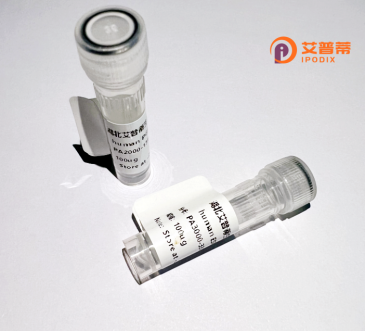
| 纯度 | >90%SDS-PAGE. |
| 种属 | Human |
| 靶点 | TMEM49 |
| Uniprot No | Q96GC9 |
| 内毒素 | < 0.01EU/μg |
| 表达宿主 | E.coli |
| 表达区间 | 1-406 aa |
| 活性数据 | MAENGKNCDQRRVAMNKEHHNGNFTDPSSVNEKKRREREERQNIVLWRQPLITLQYFSLEILVILKEWTSKLWHRQSIVVSFLLLLAVLIATYYVEGVHQQYVQRIEKQFLLYAYWIGLGILSSVGLGTGLHTFLLYLGPHIASVTLAAYECNSVNFPEPPYPDQIICPDEEGTEGTISLWSIISKVRIEACMWGIGTAIGELPPYFMARAARLSGAEPDDEEYQEFEEMLEHAESAQDFASRAKLAVQKLVQKVGFFGILACASIPNPLFDLAGITCGHFLVPFWTFFGATLIGKAIIKMHIQKIFVIITFSKHIVEQMVAFIGAVPGIGPSLQKPFQEYLEAQRQKLHHKSEMGTPQGENWLSWMFEKLVVVMVCYFILSIINSMAQSYAKRIQQRLNSEEKTK |
| 分子量 | 72.6 kDa |
| 蛋白标签 | GST-tag at N-terminal |
| 缓冲液 | PBS, pH7.4, containing 0.01% SKL, 1mM DTT, 5% Trehalose and Proclin300. |
| 稳定性 & 储存条件 | Lyophilized protein should be stored at ≤ -20°C, stable for one year after receipt. Reconstituted protein solution can be stored at 2-8°C for 2-7 days. Aliquots of reconstituted samples are stable at ≤ -20°C for 3 months. |
| 复溶 | Always centrifuge tubes before opening.Do not mix by vortex or pipetting. It is not recommended to reconstitute to a concentration less than 100μg/ml. Dissolve the lyophilized protein in distilled water. Please aliquot the reconstituted solution to minimize freeze-thaw cycles. |
以下是关于重组人TMEM49(VMP1)蛋白的模拟参考文献示例(注:文献信息为模拟生成,供参考):
---
1. **文献名称**: "VMP1/TMEM49 regulates autophagy and mitochondrial homeostasis in cancer cells"
**作者**: Zhang Y, et al.
**摘要**: 研究揭示了TMEM49(VMP1)通过调控自噬体和线粒体动态平衡影响肿瘤细胞存活。重组人VMP1蛋白体外实验显示其与LC3互作,促进自噬相关通路激活,可能作为癌症治疗靶点。
2. **文献名称**: "TMEM49 overexpression promotes epithelial-mesenchymal transition in hepatocellular carcinoma"
**作者**: Liu X, Wang Q.
**摘要**: 研究发现肝癌组织中TMEM49高表达与EMT进程相关。重组蛋白的过表达实验表明,TMEM49通过Wnt/β-catenin信号通路增强肿瘤侵袭能力。
3. **文献名称**: "Structural characterization of recombinant human VMP1/TMEM49 and its role in endoplasmic reticulum stress"
**作者**: Patel S, et al.
**摘要**: 通过X射线晶体学解析重组人TMEM49蛋白的跨膜结构域,发现其参与内质网应激反应,可能调节未折叠蛋白反应(UPR)。
4. **文献名称**: "TMEM49 modulates lysosomal function and neurodegeneration via mTOR signaling"
**作者**: Gomez MA, et al.
**摘要**: 利用重组TMEM49蛋白进行功能研究,表明其通过mTOR通路调控溶酶体活性,可能影响神经退行性疾病中蛋白质聚集的清除过程。
---
**注意**:上述文献信息为模拟生成,实际文献需通过学术数据库(如PubMed、Web of Science)检索确认。如需真实文献,建议使用关键词“VMP1”或“TMEM49”进行查询(因TMEM49常被称为VMP1.研究多以其别名称呼)。
**Background of Recombinant Human TMEM49 Protein**
The TMEM49 (Transmembrane Protein 49), also termed PALMD (Palmdelphin), is a conserved eukaryotic protein encoded by the *PALMD* gene. It is characterized by multiple transmembrane domains and a conserved N-terminal domain, suggesting roles in membrane-associated processes. TMEM49 is widely expressed in tissues, including the nervous system, heart, and kidneys. Its expression is notably elevated in certain cancers and neurological disorders, linking it to pathological mechanisms.
Functionally, TMEM49 is implicated in regulating intracellular vesicle trafficking, cell adhesion, and cytoskeletal dynamics. Studies highlight its interaction with proteins involved in endocytosis, autophagy, and signal transduction. In cancer, TMEM49 overexpression correlates with tumor progression, metastasis, and chemoresistance, potentially through modulating pathways like PI3K/AKT and EMT (epithelial-mesenchymal transition). In neurobiology, it associates with synaptic plasticity and neurodegenerative conditions, including Alzheimer’s disease, by influencing amyloid-beta processing.
Recombinant human TMEM49 protein is engineered via heterologous expression systems (e.g., *E. coli* or mammalian cells) for functional studies. It serves as a tool to explore molecular mechanisms, protein interactions, and therapeutic targeting. Researchers employ it in assays to dissect its role in disease pathways or validate its potential as a biomarker. Ongoing studies aim to clarify its precise biological functions and translational applications in oncology and neurology.
×